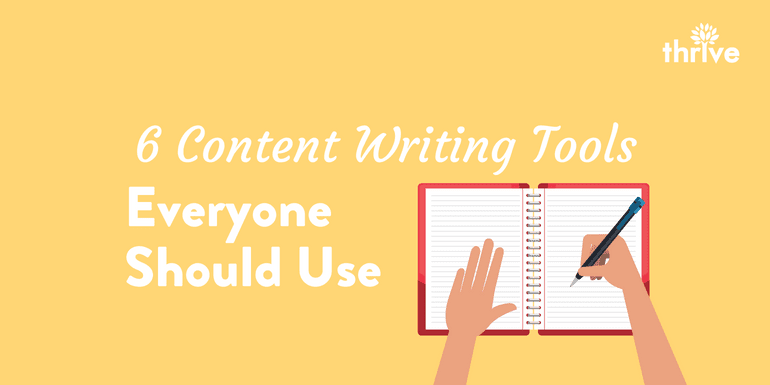Ever written a blog post or composed a web article? Then you know how much effort goes into the research, planning, writing, and optimizing of the content published on a web page.
So many details need to be included in order to create content that does it all; attracts readers, provides information, turns visitors into customers, and ranks high on search engines. All content writers know the feeling that comes when you check the clock and see that several hours have passed during what you thought was going to be a quick post.
So how can writers produce content that checks all the boxes without getting overwhelmed by all the details? There are some awesome tools and resources out there that’ll help streamline and improve the content writing process.
Here are six of our favorites!
[bctt tweet=”There are some awesome tools and resources out there that’ll help streamline and improve the content writing process. #content #contentmarketing #contentwriting #contentstrategy”]
Content Writing Tools That Make Writing Easier
Content Goal #1: Write readable language that commands attention.
People typically don’t read whole web articles – the average page visit is over in under a minute. Write content that is easy-to-read and gives the reader the information they’re after while engaging them for as long as possible.
A tool that will help: Hemingwayapp
This is a free site where you can paste the content you write and it will highlight complicated sentences, confusing words, passive phrasing, and more with color-coded marks for quick and easy edits.
Content Goal #2: Come up with great content ideas and eye-catching titles to match, while using keywords naturally.
Planning out your content topic and title is one of the most important – and difficult – tasks in content writing. These important aspects need to capture a reader’s attention while communicating to search engines the topic for indexing.
A tool that will help: Blog Topic Generator
Simply paste in the keyword/s that you want to focus on and this tool will spit out topics and titles. You can use this to plan for a series of blog posts or to come up with a great title without wasting too much time brainstorming.
Bonus: The Top 10 Tools & Resources for Finding Blog Content Ideas
Content Goal #3: Create original content.
If you haven’t figured it out yet, copying other people’s content is bad. People know that duplicating content is cheating, and so do search engines. If your site contains content that can be found elsewhere on the internet, search engines will penalize the site by making it difficult to find, or remove it entirely, from search results. Take the time to be original.
A tool that will help: Siteliner
With this tool, you can scan your content to quickly check for duplicate content. If you want to be extra careful, you can even use it to find single sentences or phrasing to make sure you haven’t, unfortunately, duplicated someone else’s content even slightly (unintentionally, of course)!
Bonus: Top Duplicate Content Checkers for Website Content
Content Goal #4: Illustrate content points to break up text walls.
Creating and placing images is not technically part of actual content writing, but it IS a great tip for presenting your content in an attractive manner. Remember that people scan web content, and they’ll find a wall of text intimidating.
A tool that will help: Canva
Enough praise cannot be given to Canva, for it is truly a magnificent image creation tool. You can select your image type from many different options (banners, photos, social media, and more) or choose a custom size. With hundreds of free templates, backgrounds, images, icons, etc. and thousands more for $1 each, you will never run out of inspiration and the ability to create professional quality images.
Content Goal #5: Write optimized content that converts.
Search engine optimization and conversion optimization are two separate content writing goals, but when the correct balance is struck between them, the result is web content that reads and performs beautifully.
Tools that will help: Web Content Checklist and Writing For Conversion
These tools are actually articles, but the guidance they provide is invaluable. Give them a good, hard read and you’ll have the tips needed for content writing that is optimized for conversion and search.
Content Goal #6: Choose and insert the best keywords.
Keywords are the most important feature in content writing. Without the proper, relevant keywords, search engines don’t know how to categorize your website for SEO. If your website isn’t indexed properly by search engines, it’s going to be far more difficult to be found amongst the millions of other sites on the internet. Make sure you choose keywords that fit your topic (and topics that fit your keywords) for better keyword inclusion.
A tool that will help: Keyword Planner
This is pretty much the official keyword research tool, as it is Google’s own. It fulfills the whole gamut of keyword research needs, whether you’re designing content for your website or writing copy for a social media campaign. You can enter your topic, industry, website, and more to have a selection of keywords organized by subject, popularity, level of competition, etc. This tool should be your first stop when picking the perfect keywords for your content writing.
Bonus: 18 Free Keyword Tools for Landing High Rankings
Content writing just got a little easier.
Hopefully, some of these content writing tools were exactly what you were looking for and with them, your content writing tasks will go smoothly. If you’d like to learn more about content writing, check out these articles:
- Top 20 Do’s and Don’ts of Content Writing
- How to Write Website Content in 2018
- Content Marketing Basics: How Content & SEO Work Together
And of course, if you need any SEO content writing done for your site, contact Thrive!
